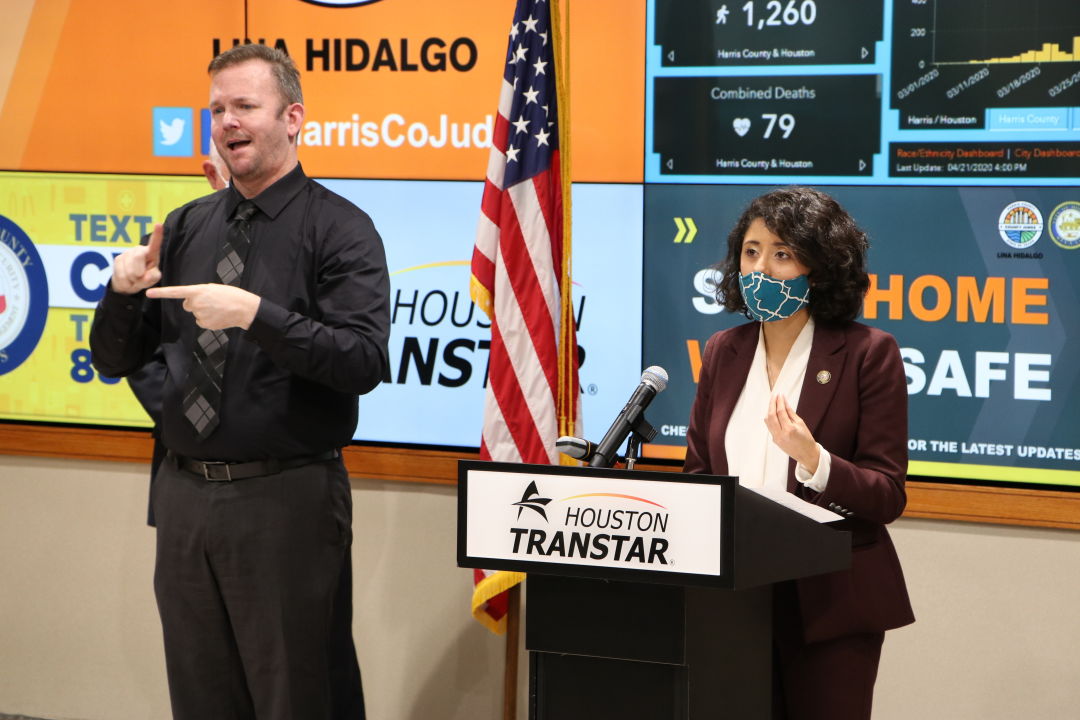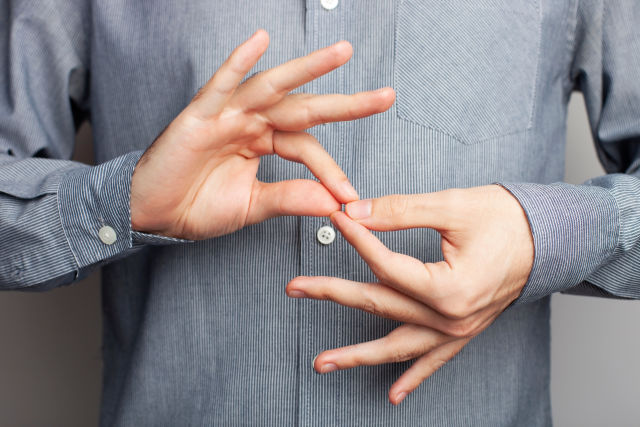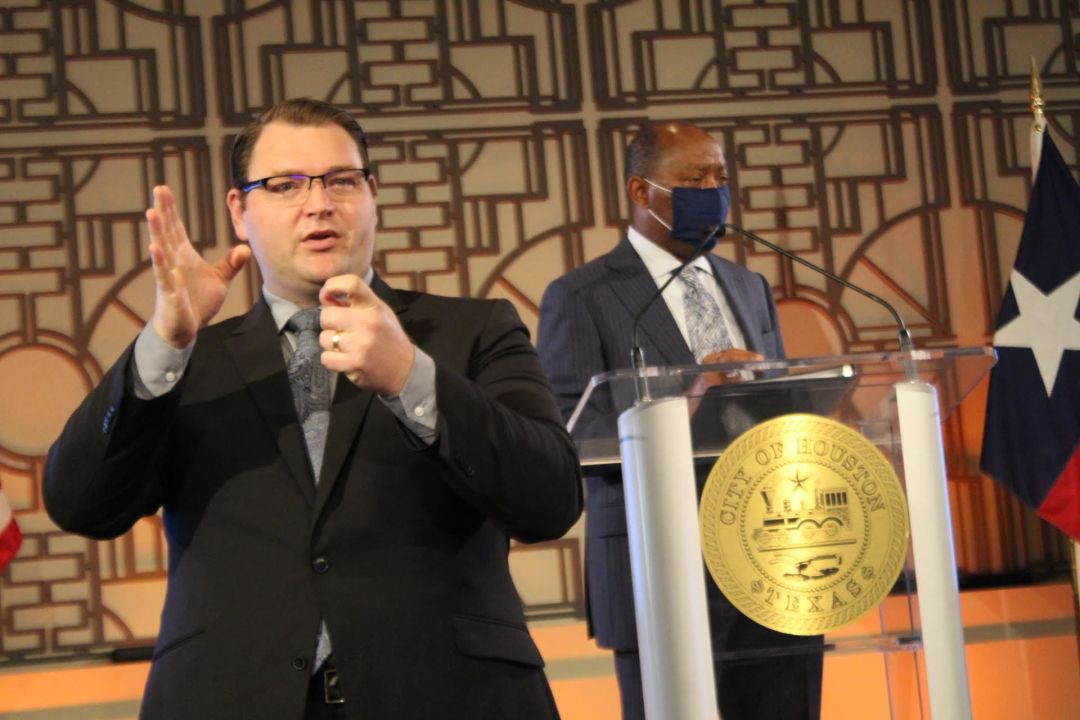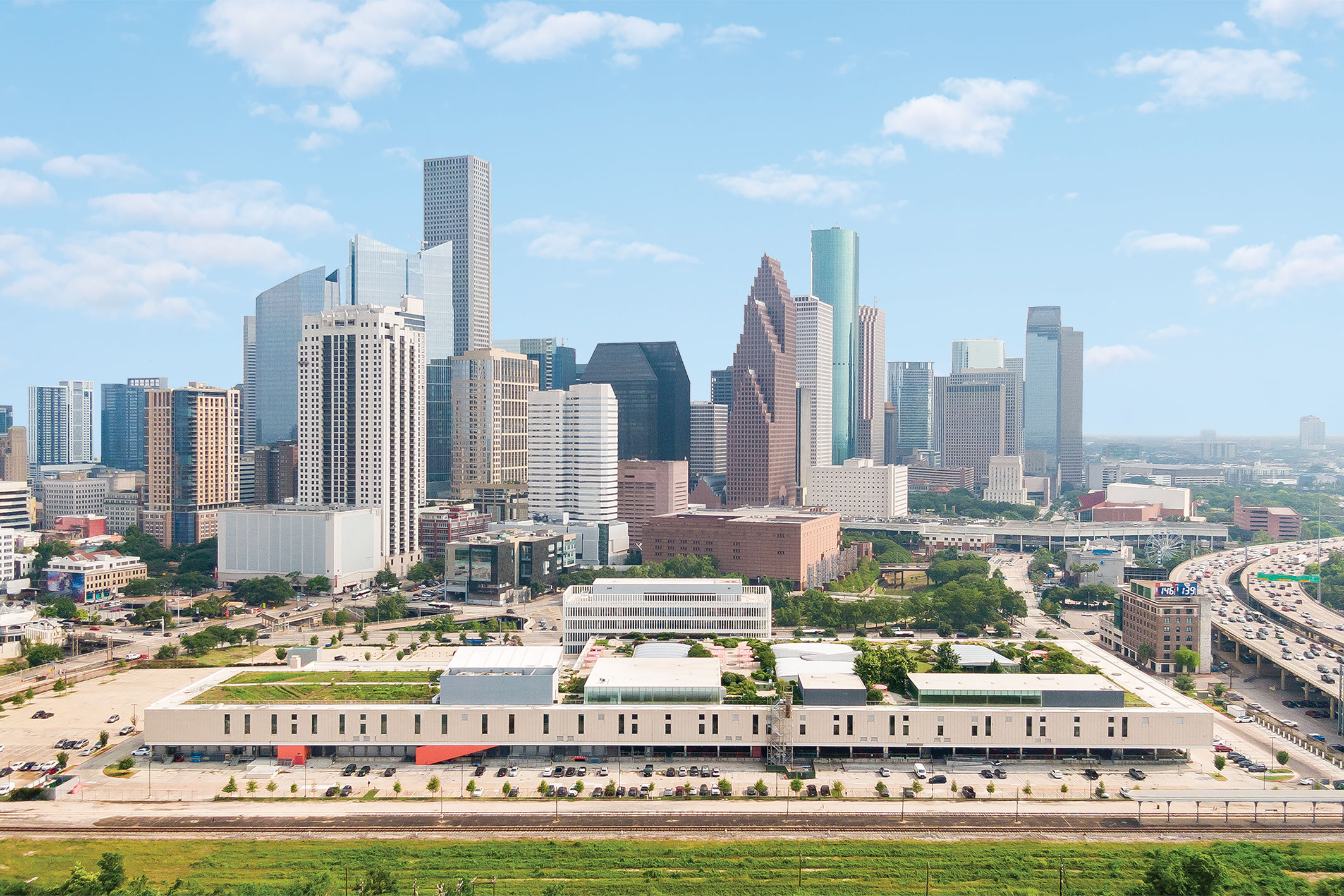Face Masks Complicate Communication for Houston’s Deaf Community

Certified Deaf Interpreter M. Cody Francisco signs for Judge Lina Hidalgo during a Harris County press conference on the coronavirus pandemic.
Image: Courtesy HCOHSEM
Public officials have become regular fixtures on our TVs these days, but they’re rarely alone. There’s almost always an ASL interpreter gesturing near the podium. Houston-area interpreters have suddenly found themselves in the limelight, but it’s not their work that’s drawing this newfound attention. It’s the fact that they’re not wearing face masks while on camera during press conferences.
And for people so dedicated to their work, the pushback has been difficult.
“Most of the people who have comments don't understand the full requirements of the language in the Deaf community,” says Certified Deaf Interpreter M. Cody Francisco, who works with the Harris County municipal government. “Their lack of knowledge doesn’t give them a whole understanding of why the interpreters are not wearing masks.”
Signs and Signals
Interpreting is not just giving a word-for-word translation of what a person is saying. It’s also about conveying the cultural and linguistic context and prosodic—pitch and intonation—nuance in a person’s message.
“The mayor or the judge is not going to say, ‘This is a terrible situation, this is unprecedented,’ but the meaning behind what they’re saying is packed into the words they’re using,” Francisco says. “And so, we convey the meaning, not just the words. It’s important the Deaf community actually gets the weight of the full message, including what’s underlying.”

Image: Shutterstock/ Ovsianka
Relaying all of this information involves not just the signs that make up American Sign Language (ASL), but facial expressions, body language, and mouth movements called mouth morphemes, which add substance, subtext, and description, like mortar holding the bricks of language together.
“Eighty to 90 percent of American Sign Language aren't the signs themselves,” Francisco says, “and if we have a mask, then we're removing those adjectives, those adverbs—all of that grammar.”
Even deaf individuals who are able to read lips only pick up about 40 percent of the message at best, and live captioning is often filled with mistakes and omissions making it less than reliable, says Randy Thuesen, a trilingual interpreter (English, Spanish, and ASL) who has worked with the city of Houston during previous disasters including Hurricane Harvey and the ITC chemical spill.
A crisis is hardly the moment you want to risk someone not fully comprehending an official public message, and the current pandemic, along with Harris County’s ensuing face mask order, has made things challenging enough for deaf individuals without forcing them to guess what exactly an interpreter is trying to convey.

Interpreter Randy Thuesen (foreground) translates Mayor Sylvester Turner's statement on the coronavirus during a press conference held by the city Houston.
Image: Anne Raegan/City of Houston
The (New) Struggle Is Real
Using a mask every day has left many members of the Deaf community, who rely on seeing facial expressions, feeling isolated and disconnected from the world around them, says Francisco, who himself is Deaf, with a capitalized "d" to convey not only his medical condition but also his cultural identity. Most members of the Deaf community live with individuals who can hear and don’t sign, instead relying on others within the community to feel fully connected to their culture and identity. Now, they’re separated from that anchor and support system.
Francisco has avoided stores as much as possible, choosing to use curbside pickup, where he can place his order without have to ask an attendant where something is, whenever he can. Other members of the community have taken to broadcasting their deafness to those around them by physically writing out messages on their masks, which some fear may lead to later discrimination, Thuesen adds. Drive thrus have historically been a struggle since they require talking into a speaker to place an order, Francisco says, but the coronavirus has turned this into a bigger issue as walking inside and placing an order is no longer an option. “I struggle already as a Deaf person just to survive and navigate a hearing world. I don’t want to have to fight any more.”
Social distancing is making it even more difficult for individuals with combined hearing and vision loss, called deafblindness, who rely on tactile ASL, where the client places his or her hands directly on top of the interpreter’s to feel the signs, Francisco says. “I do have many clients who are DeafBlind, and they’re completely removed from communication at this point.”

While it may not look like it on screen, Certified Deaf Interpreter M. Cody Francisco practices social distancing, standing six feet away from Judge Lina Hidalgo and others, during press conferences.
Image: Courtesy HCOHSEM
Full Transparency
Because of the pandemic, some of these barriers are simply unavoidable, so having easy access to the same public messages makes a difference for deaf individuals. Ensuring they get the complete memo is paramount, and that means foregoing a mask on camera—a decision neither Francisco nor Thuesen take lightly.
Both interpreters aren’t necessarily opposed to wearing masks. In fact, Thuesen has spent the last month looking into various facial coverings trying to find one that wouldn’t obstruct his face (including his nose and cheeks, which are key components of signing) or distract the viewer. So far, he hasn’t had any luck, but when so much is at stake, you can’t worry about politics or optics, Thuesen says.
Some interpreters are turning down jobs because they don’t want to take off their masks, Francisco adds. It’s a difficult choice, but, just like medical professionals on the front lines, the interpreters know the risks. Plus, those watching on their screens at home also can’t see what’s happening behind the scenes. The interpreters show up for press conferences wearing their masks and only take them off when officials arrive. Once the conference ends, the masks go right back on—and stay on the entire time the interpreters are out in public.
“I just went to the grocery store and Home Depot, and I was wearing a mask,” Francisco says. “It was kind of nice wearing the mask, actually. No one recognized me from TV.”




